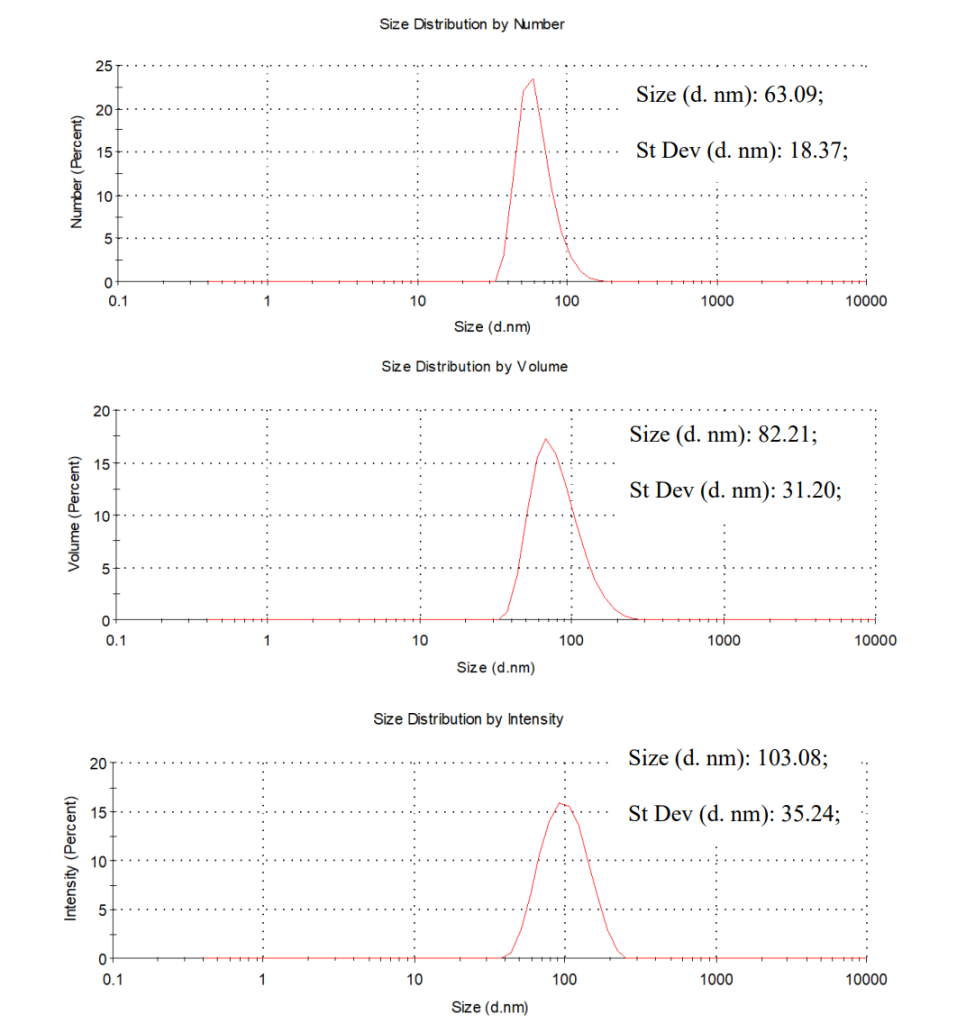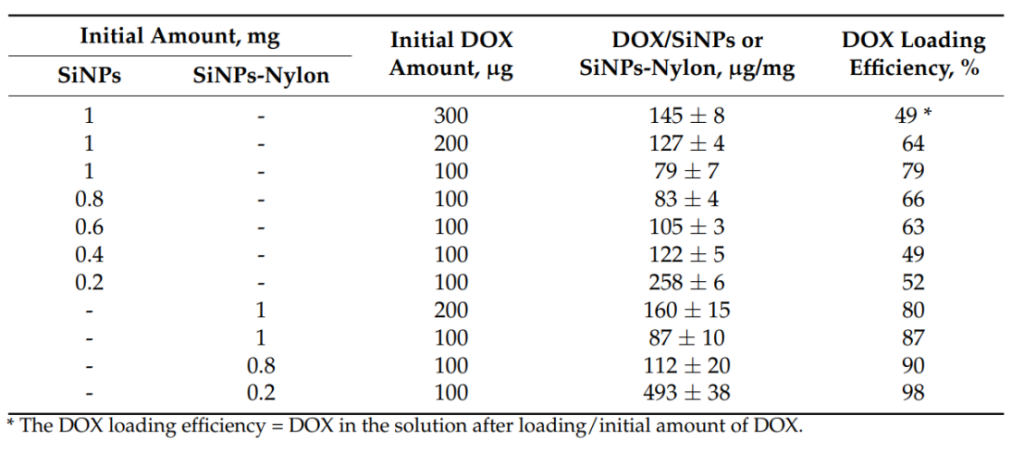Editor:Nina
This study presents the synthesis and characterization of doxorubicin-loaded silica and nylon-coated silica nanoparticles (SiNPs-Nylon) for targeted cancer treatment, demonstrating high drug loading capacity, pH-sensitive drug release, and enhanced cytotoxicity against cancer cells, offering promising potential for cancer therapy.
Key Preview
Research Question
This study investigates the optimization of silica nanoparticles (SiNPs) loaded with doxorubicin for targeted cancer therapy, addressing challenges in drug delivery systems.
Research Design and Strategy
A systematic approach was employed, utilizing various synthesis methods to produce SiNPs and SiNPs-Nylon, followed by comprehensive characterization to evaluate their morphology, stability, and drug loading efficiency.
Method
The research involved the synthesis of SiNPs, coating them with nylon 6, loading doxorubicin, conducting pH-dependent drug release studies, and assessing cytotoxicity on cancer and control cell lines.
Key Results
The study found that doxorubicin-loaded SiNPs demonstrated a drug loading capacity of 258 µg/mg, while SiNPs-Nylon achieved 493 µg/mg, with significant cytotoxicity against cancer cells.
Significance of the Research
The research highlights the potential of silica nanocomposites in enhancing cancer treatment by improving drug delivery and reducing side effects through targeted, pH-sensitive drug release.
Introduction
The evolution of nanomedicine has paved the way for innovative approaches to cancer treatment, particularly through the development of nanoparticle-based drug delivery systems. Silica nanoparticles (SiNPs) have emerged as promising candidates due to their stability, biocompatibility, and customizable surface properties. Recent advancements in the synthesis of SiNPs have enhanced their potential applications in drug delivery, functional coatings, and biomolecule separation.
The current research introduced in the paper titled “Doxorubicin-Loaded Silica Nanocomposites for Cancer Treatment” addresses critical challenges in drug delivery, particularly the limitations of conventional chemotherapy methods that often lead to systemic toxicity and drug resistance. The study focuses on optimizing the synthesis and functionality of SiNPs, exploring their application as carriers for doxorubicin, a widely used chemotherapeutic agent.
The need for this research is underscored by the increasing prevalence of cancer and the urgent requirement for more effective and less toxic treatment modalities. By enhancing the delivery and efficacy of doxorubicin through engineered silica nanocomposites, the study aims to contribute significantly to the field of cancer treatment.
Research Team and Objective
The research team, composed of Victoriya Popova, Yuliya Poletaeva, Alexey Chubarov, Dmitrii Pyshnyi, and Elena Dmitrienko, conducted this study at the Institute of Chemical Biology and Fundamental Medicine, SB RAS, in Novosibirsk, Russia. The paper was published in the journal Coatings in February 2023. The primary objective of this research was to synthesize and characterize doxorubicin-loaded silica nanocomposites and evaluate their potential as a targeted delivery system for cancer treatment.
Experimental Process
Outline:
- Synthesis of Silica Nanoparticles (SiNPs)
- Synthesis of Nylon-Coated Silica Nanoparticles (SiNPs-Nylon)
- Loading of Doxorubicin (DOX) onto SiNPs and SiNPs-Nylon
- Doxorubicin Release Studies
- Cytotoxicity and Cell Viability Assays
1. Synthesis of Silica Nanoparticles (SiNPs)
- Key Steps: The SiNPs were synthesized by a modified sol-gel process using tetraethoxysilane (TEOS) as a precursor. An alcohol solution of TEOS was mixed with ammonia, followed by sonication for 60 minutes. The reaction continued for 12 hours to form a white suspension, which was then centrifuged. The resulting SiNPs were washed multiple times with ethanol to remove impurities.
- Results and Key Data: The SiNPs produced had an average size of 63 nm, with a low polydispersity index (PDI) of 0.09, confirming their monodispersity and suitability for biological applications. The size was confirmed using dynamic light scattering (DLS) and transmission electron microscopy (TEM).

Figure 1. DLS size distribution data (Number, Volume, and Intensity) for method with 0.018 M TEOS. The particle size by Number is 63 ± 1 nm (PDI = 0.09 ± 0.01).
- Significance of the Results: The uniform size and high monodispersity of SiNPs are crucial for ensuring consistent drug loading and targeted drug delivery. The controlled size also enhances biocompatibility, preventing rapid excretion through the renal system.
- Key Innovations: The use of a modified sonication technique in the synthesis process enhanced the uniformity and stability of the SiNPs, addressing previous challenges in obtaining stable, non-toxic, and effective nanoparticles.
2. Synthesis of Nylon-Coated Silica Nanoparticles (SiNPs-Nylon)
- Key Steps: SiNPs were functionalized with 3-aminopropyltriethoxysilane (APTES), followed by the addition of cyanuric chloride to activate the surface. Nylon 6 was then conjugated onto the activated surface, forming the SiNPs-Nylon composite.
- Results and Key Data: The SiNPs-Nylon composites had a hydrodynamic diameter of 110 nm and a PDI of 0.16. TEM imaging revealed uniform spherical particles with a high surface-to-volume ratio, and the ζ-potential of the SiNPs-Nylon was +30 mV, indicating stable dispersion in aqueous solutions.

Table 1. Hydrodynamic diameter and polydispersity index(PDI) of SiNPs and SiNP-Nylon obtained by DLS.
- Significance of the Results: The nylon coating improves the colloidal stability of the SiNPs and may offer enhanced drug encapsulation properties due to the unique polarity of nylon, which interacts with both hydrophobic and hydrophilic molecules. This makes the composite suitable for controlled drug delivery.
- Key Innovations: The combination of SiNPs with a nylon coating represents a novel strategy to enhance stability and drug loading capacity, demonstrating an improvement over previous silica-only nanoparticle systems.
3. Loading of Doxorubicin (DOX) onto SiNPs and SiNPs-Nylon
- Key Steps: DOX was loaded onto the SiNPs and SiNPs-Nylon composites by incubation in a sodium borate buffer at pH 8.0. The drug loading capacity was calculated by measuring the unbound drug after centrifugation.
- Results and Key Data: The loading capacity for DOX was found to be 258 µg/mg for SiNPs and 493 µg/mg for SiNPs-Nylon, with loading efficiencies of 52% and 98%, respectively. This suggests that nylon-enhanced SiNPs provide a significantly higher drug loading capacity.

Table 2. DOX loading SiNPs and SiNPs-Nylon capacity.
- Significance of the Results: The higher drug loading capacity of SiNPs-Nylon ensures a more potent and effective delivery system for cancer therapy, making it a more suitable candidate for treating tumors that require high drug doses.
- Key Innovations: The incorporation of nylon not only improved drug loading but also potentially enhanced the release properties by facilitating interactions between the drug and the carrier material, addressing the challenge of efficient drug encapsulation in traditional nanoparticle systems.
4. Doxorubicin Release Studies
- Key Steps: The release of DOX from SiNPs and SiNPs-Nylon composites was monitored in sodium acetate buffer with pH ranging from 3.0 to 7.0, mimicking the acidic conditions found in the tumor microenvironment. Temperature-dependent release was also investigated.
- Results and Key Data: DOX release was pH-dependent, with higher release rates at acidic pH (around pH 5), typical of the tumor microenvironment. The SiNPs-Nylon composites exhibited a higher release capacity than SiNPs at pH 5, further demonstrating the advantage of nylon coating.

Figure 2. DOX release from SiNPs-DOX (A,C) and SiNPs–Nylon-DOX (B,D) at pH 3.0–7.0 at 25 °C
- Significance of the Results: pH-sensitive release mechanisms are critical for targeted drug delivery, ensuring that the drug is released preferentially in the tumor site while minimizing systemic side effects. This mechanism is vital for increasing the therapeutic efficacy of DOX while reducing toxicity.
- Key Innovations: The pH-responsive behavior of SiNPs-Nylon offers a more efficient drug release profile compared to traditional drug delivery systems, enhancing the precision of drug delivery in cancer treatments.
5. Cytotoxicity and Cell Viability Assays
- Key Steps: The cytotoxic effects of the SiNPs-DOX and SiNPs-Nylon-DOX composites were tested on A549 lung cancer cells and HEK 293FT cells using the MTT assay. Various concentrations of SiNPs, SiNPs-Nylon, SiNPs-DOX, and SiNPs-Nylon-DOX were incubated with the cells for 48 hours.
- Results and Key Data: SiNPs and SiNPs-Nylon showed no acute toxicity at concentrations up to 50 µg/mL. The IC50 value for SiNPs-DOX was 0.98 µM for A549 cells, with a significantly lower IC50 for SiNPs-Nylon-DOX, demonstrating its superior anticancer activity.

Table 3. The IC50 values of SiNPs-DOX and SiNPs-Nylon-DOX for the A549 cell line per DOX or nanoparticles concentration.
- Significance of the Results: The low toxicity of SiNPs and SiNPs-Nylon in non-cancerous cells (HEK 293FT) suggests that these nanoparticles are safe for use in drug delivery systems, while the enhanced cytotoxicity of SiNPs-DOX and SiNPs-Nylon-DOX confirms their potential as effective cancer therapies.
- Key Innovations: The dual advantage of high drug loading and targeted release at acidic pH ensures that the composites are not only potent against cancer cells but also biocompatible, minimizing side effects.
Conclusion
The study presents compelling findings highlighting the efficacy of doxorubicin-loaded silica nanocomposites as a promising strategy for cancer treatment. The synthesized SiNPs and SiNPs-Nylon exhibited high drug loading capacities and demonstrated effective cytotoxicity against cancer cell lines. The implications of this research extend to the development of innovative drug delivery systems that leverage the unique properties of silica nanoparticles to improve therapeutic outcomes in cancer therapy.
While the study achieved significant advancements, it also acknowledged limitations, including the need for further exploration of in vivo effects and potential long-term toxicity. Future research should focus on optimizing the nanoparticle design for enhanced stability and efficacy, as well as conducting comprehensive in vivo studies to validate the therapeutic potential of these nanocomposites in clinical settings.
Reference:
Popova, Victoriya, et al. “Doxorubicin-loaded silica nanocomposites for cancer treatment.” Coatings 13.2 (2023): 324.
